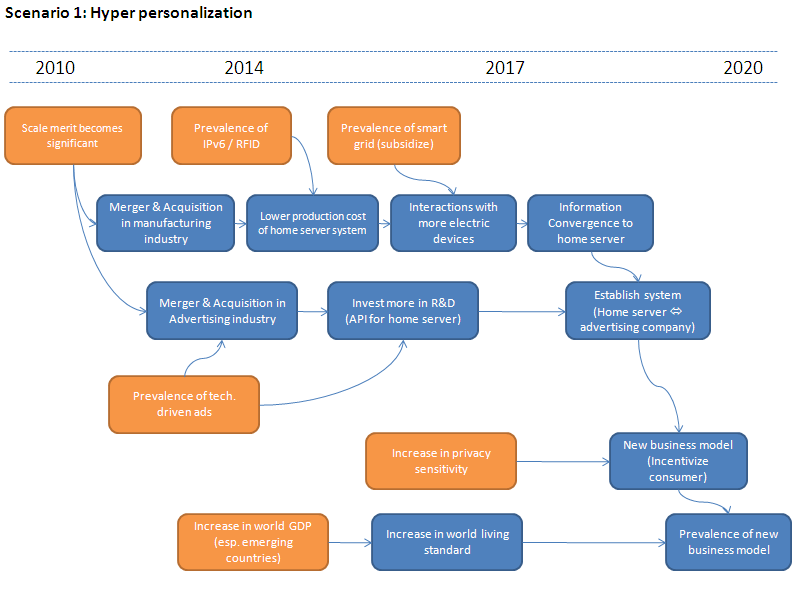Scenario 1: Hyper Personalized age
Description(!Work in progress!)
- Scenario Flow
2010
As world economy becomes globalized, the company scale has been a critical factor to win in the market. Complying with this trend, corporations in varied industries accelerate the merger and acquisition strategy to achieve the scale merits. In manufacturing industry, corporations accomplish the lower production and logistic cost and stronger sales and procurement channels, consequently lowering the product price. Like wisely, numerous integrations are observed in advertisement industry. In addition to the scale merit, advertisement companies attempt to acquire the key technology to prosper in the future market. Increasing importance of the Information Technology, especially web advertising technology such as Google’s adwords, induces companies to achieve the horizontal integrations.
2014
More intense R&D investments and higher efficiency generated through the merger and acquisitions in manufacturing industry results in prevailing varied new technologies that influences advertising business. IPv6 technology, which had been established for many years but not been commercialized due to the high production cost, is a good example. With IPv6, we can allocate IP address to electric devices at home and allow them to communicate each other. The technology potentially impacts on advertising industry since it stores the consumers’ life style information with which advertises can directly deliver more attractive advertisements matching each consumer’s interest. (See scenario 2020 for details) The lower production cost allows manufactures to embed IPv6 technology in their wide range of the product line. Concurrently, home server system which communicate with and controls them while centralizing the personal log information also starts being prevailed.
Furthermore, under the post Kyoto protocol, governments introduce to households the smart grid technology that manages the home electricity utilization with its subsidizing policy. Smart grid can also send to the home server the consumers’ life style information such as the time they wake up and sleep or whether they cook or not.
2017
Advertising companies that have advanced its IT competence developed the system that interacts with home servers in each household. Through the system, the advertising companies will be able to take in consumers’ personal information, including TV programs they watch, content in refrigerator, music they play and web sites they visit, accurately analyze the personal interests and deliver the appropriate advertisements to appropriate place. (See scenario 2020 for details)
However, increasing sensitivity to consumer privacy and critics from consumer organizations inhibit advertising companies from promoting the system. In a mean while, advertising companies overcome this situation with new business scheme where consumers are financially incentivized by providing their personal information. Consumers can receive adequate monetary value from advertising companies or obtain high spec home server system for free in exchange of their personal information.
2020
As a result, more than 65% of consumers operate the home server under the incentive scheme. Home server manages almost all of the electric devices at home varying from TV to music plays, PC, mobile phones, automobiles, refrigerators, cooking system and smart energy system. Strong economic growth especially in emerging markets encourages the penetration of home server system and the new business model.
Now advertising companies can deliver the right advertisements at the right time to the right place. Personal information in the home server provides the highest degree of personal interests based on which advertising companies can identify the most suitable advertisements. The real-time interactions with home servers allow advertising companies to select the most effective timing to send the advertisements. In particular, advertising companies are able to deliver the foot ball shop advertisements to those who spend more than 2 hours on watching foot ball matches per week and display on the TV screen when they are actually watching matches on TV. Additionally, after analyzing the foods stock information from the refrigerators, advertising companies also send grocery shop advertisements, showing foods necessary to buy, to the vehicles when consumers drive back home from the office.
Driving Forces(!Work in progress!)
Economy
- Scale merit
- Increase in world GDP
Technology
- IPv6
- Smart grid
Policy
- Sustainable policy
Society
- Sensitivity to privacy
